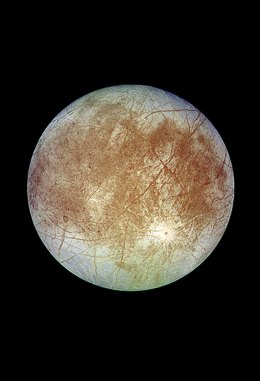
Europa
The search for life beyond Earth has generally focused on places that are as much like our home as possible. That’s why the Kepler space mission has gotten headline after headline after headline in recent years, as it discovers Earth-like planets where no one had even looked before. It’s also why NASA and other space agencies have trained their sights so powerfully on Mars, where polar ice caps wax and wane with the seasons and water once flowed freely across the landscape.
The fact, however, say astrobiologists, is that the earthiness of a distant world is less essential for life than is the existence of water there in its liquid state. And that fact is what makes Jupiter’s moon Europa perhaps the most fascinating of all the potentially life-bearing worlds. At nearly 800 million km from the sun compared with Earth’s 150 million km, Europa is covered in a kilometers-thick rind of ice, but beneath it lies a watery ocean. And now, says a new paper in Nature Geoscience, there’s evidence that this ocean is roiling with powerful currents that could be concentrating any life-forms — if they exist — near the moon’s equator. “The conclusions are remarkable,” says Jason Goodman, a planetary scientist at Wheaton College, near Boston, who wrote a commentary accompanying the new study.
That oceans could exist at all on Europa was remarkable enough when the Voyager and Galileo probes found that the moon was indeed covered with ice — as astronomers had long suspected — but that the ice was cracked and jumbled, making it clear that it was floating on what must be a subsurface, moonwide ocean. In retrospect, it made sense: Europa’s solid core flexes with powerful tides imposed by the mammoth planet nearby and by interactions with other moons. Tidal friction generates heat, which keeps the salty ocean permanently unfrozen.
(MORE: A Living Ocean on a Jovian Moon?)
Europa’s icy shell shows its signature cracks everywhere, but the region around the moon’s equator is especially torn up, with huge chunks of ice that have clearly broken away and refrozen in a chaotic pattern known (unsurprisingly) as “chaos terrain.” The reason, theorists have long suspected, is that the upwelling of warmer water from the seafloor would force the ice upward, cracking it. The problem is that most ocean-circulation models to date predict the upwelling and cracking should happen at the poles.
In the new study, University of Texas geophysicist Krista Soderlund and several colleagues used more-sophisticated global ocean-circulation models, originally designed to study the earthly seas, and found instead that the upwelling should happen at the equator — and that given Europa’s spin, heat flow and other factors, it should percolate upward at a brisk 1 m per second or so. “That’s very fast compared with currents on Earth,” says Goodman. “I’m not 100% sure they’re right.”
(MORE: Lasers Could Help Cryobots Melt Through Ice on Europa)
But Soderlund isn’t claiming certainty either. “Others have argued that the chaos terrain formed toward the poles,” she says, where earlier studies have put the upwelling warmer water as well, “and that the ice sheet has reoriented itself. We think our explanation is more convincing.” If nothing else, that explanation has the virtue of simplicity: it’s easier to posit that earlier models were wrong than that an entire global ice layer has been shifting its position.
If Soderlund and her colleagues are right, the implications for a future life-hunting mission could be enormous. “The intensely broken and fragmented ice in the chaos terrain could give us better access to the ocean below,” says Goodman. Plus the upward current could bring nutrients and even living organisms from the oceanic depths to a place, relatively close to the surface, where they’d be within range of an under-ice rover of some sort.
(MORE: A Brand New Ocean on Saturn’s Moon Titan)
Unfortunately, such a mission would be incredibly ambitious, and none is even close to being in the works. The closest we have are the European Space Agency’s Jupiter Icy Moons Explorer, slated for a 2022 launch and arrival in the Jovian system in 2030, and the Jet Propulsion Lab’s Europa Clipper, which hasn’t even been approved yet. Both would be flyby missions, with no landing capability, so a direct search for Europan life is probably decades away.
But if we find a truly Earth-like planet around another star — even the closest star to the sun — it would literally take centuries to get there and start exploring. Compared with that, a jaunt to Europa to drill through a paltry few kilometers of ice in search of alien life sounds like an afternoon’s work.
VIDEO: More Proof That Getting Clobbered by Comets Led to Life

